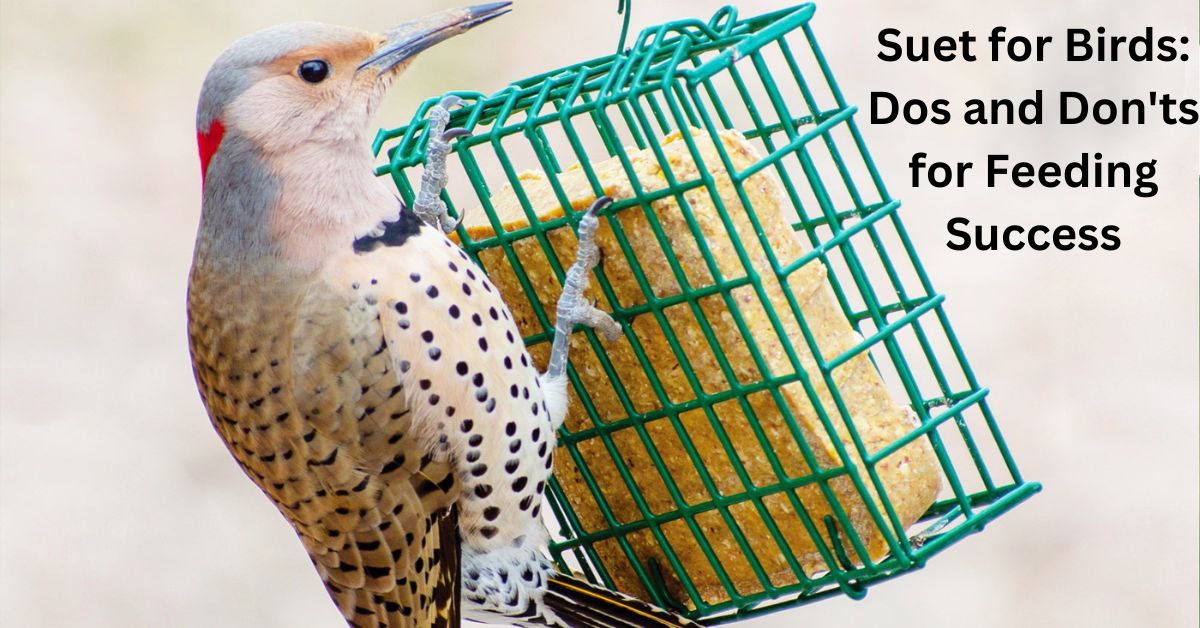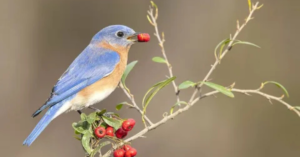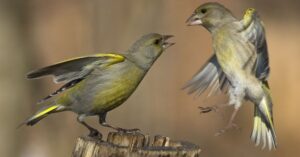As winter’s chill sets in and natural food sources dwindle, backyard birdwatchers often seek ways to attract feathered friends to their gardens. One of the most effective means is offering suet, a high-energy food that provides a vital source of nutrition for many birds during the colder months.
But before you rush out to hang a suet cake, it’s essential to understand the dos and don’ts of offering this delightful treat. Not all suet is created equal, and knowing what birds eat suet can make all the difference in your avian feeding success.
In this article, we’ll cover the best practices for introducing suet into your bird-feeding repertoire while ensuring that you’re doing it safely and effectively.
From selecting the right type of suet to knowing which species will flock to your feeder, you’ll gain valuable insights that will not only enhance your backyard birdwatching experience but also contribute positively to their well-being during tough weather conditions.
DO Learn Which Birds Will Eat Suet
To attract suet feeder birds, understanding which species enjoy this high-energy treat is essential for any bird lover. Suet for birds provides a rich source of fat that especially appeals to woodpeckers, nuthatches, and various types of chickadees.
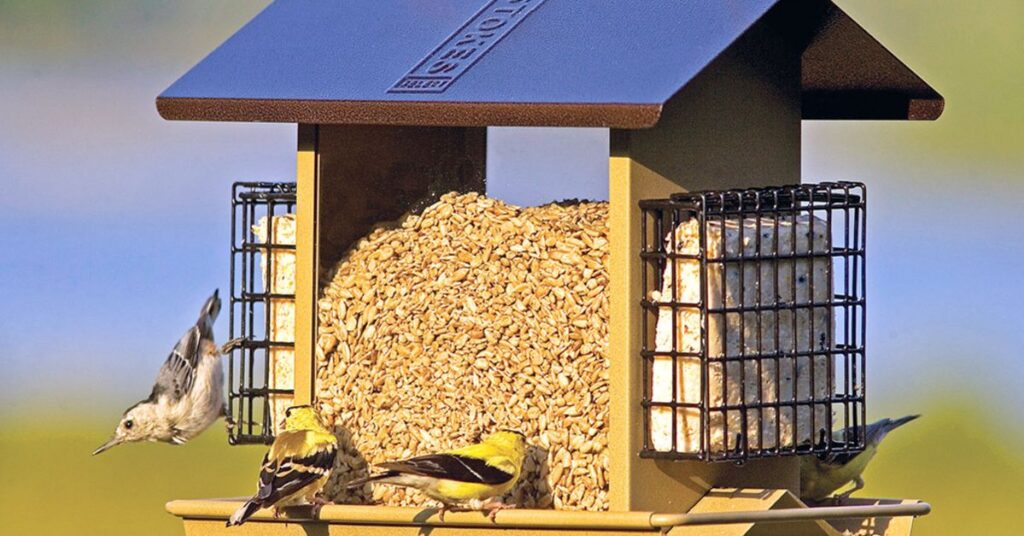
These birds are often drawn to suet during colder months when natural food sources are scarce, making your feed station a vital lifeline for them.
It’s not just the familiar visitors you may think of; larger species like feeding jays and even some sparrows can also take advantage of suet feeders. Utilizing a variety of suet blends can attract an even broader array of feathered friends. Adding seeds or fruit bits into the mix can entice other birds while ensuring your feathery guests keep returning throughout the season.
With careful selection and placement of your suet feeder, you’ll be rewarded with mesmerizing views as an assortment of avian creatures flock to dine at your garden’s nourishing hub.
DON’T Give Up If You Don’t Attract Your Favorite Birds Right Away
Attracting your favorite birds can be a rewarding experience, but patience is key when using suet bird feed. It’s essential to remember that different species might take time to discover your feeder, especially if they are accustomed to other food sources.
Consider varying the types of suet you provide or placing feeders in diverse locations around your yard to enhance visibility and accessibility for visiting birds.
DO Try Making Your Own Suet
Creating your own bird suet is not only a rewarding endeavor but also an effective way to attract various feathered friends to your backyard. By making your own suet block, you have control over the ingredients, allowing you to cater specifically to the preferences of local birds and avoid fillers found in commercial options.
Common ingredients include rendered animal fat, peanut butter, seeds, and dried fruits—each providing essential energy for birds, especially during colder months.
Besides the satisfaction of crafting your bird suet from scratch, it can be a fun activity for families. Involving kids in this project sparks curiosity about wildlife while fostering appreciation for nature.
DON’T Fill It With Sugary Ingredients
When creating a suet bird feeder, it’s crucial to consider the health and well-being of your feathered visitors. Many might be tempted to fill the bird suet feeder with sugary ingredients, thinking they will attract more birds.
Excessive sugar can be detrimental to birds, leading to potential health issues. Instead of sweeteners, opt for natural fats like rendered beef fat or lard blended with seeds and fruits that provide essential energy during colder months.
By incorporating these heart-healthy options into your suet bird feeder, you’ll create a nutritious treat that promotes avian vitality. Adding ingredients such as unsalted peanuts or dried fruit not only enhances flavor but also offers high-protein benefits without compromising the birds’ dietary needs.
So next time you’re preparing your bird suet feeder, remember that quality matters – prioritize wholesome sources over sugary temptations to foster a thriving backyard ecosystem enriched by healthy visits from various bird species.
DO Buy Your Suet In Bulk
Investing in suet bird feeders is an excellent strategy to attract a diverse array of birds to your backyard. These specialized feeders not only provide a high-energy food source for birds during colder months, but they also ensure that your feathered friends stay well-nourished and come back for more.
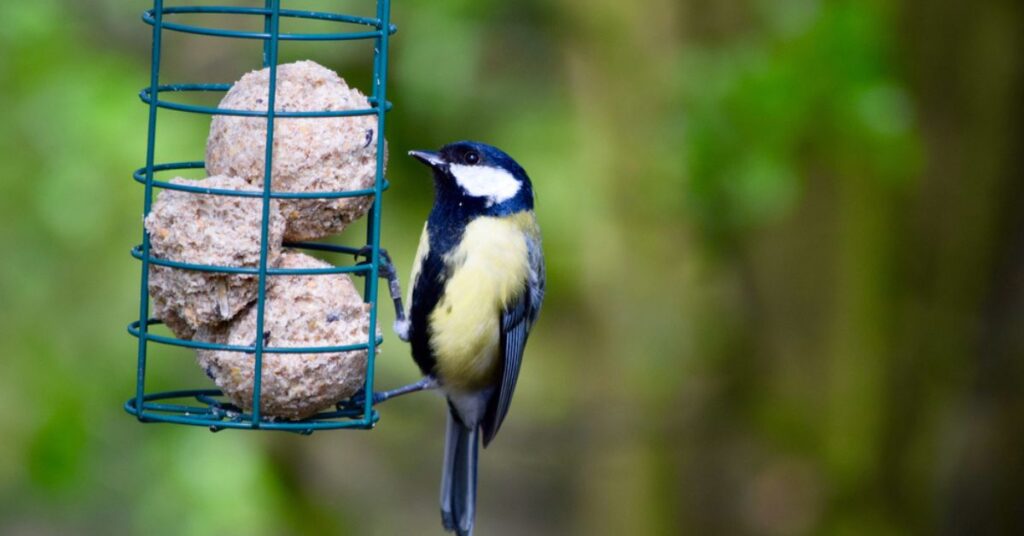
By choosing to buy your suet in bulk, you can save money and ensure that you have a steady supply on hand, making it easier to keep your feeders filled and the birds happy.
Understanding which is the best suet for birds can greatly enhance their feeding experience. Opt for suet blends that include seeds, fruits, or nuts—these additions create an irresistible treat for various bird species.
Consider temperature when selecting suet; higher-quality options resist melting in warm weather while remaining palatable during winter chills. By curating the ideal selection of suet in bulk, you’re not just providing sustenance; you’re creating an inviting habitat that supports local wildlife throughout the year.
DON’T Leave It Where Critters Can Get To It
To nurturing our feathered friends, bird suet cakes are an excellent way to provide the essential fats and nutrients they crave, especially in colder months. One critical tip for maximizing their effectiveness is to ensure that you don’t leave these suet cakes where critters can get to them.
While feeding birds brings joy and sustenance, attracting unwanted guests like raccoons or squirrels can quickly turn your backyard into a chaotic scene. To prevent this, consider using specialized feeders designed to keep larger animals at bay while allowing birds easy access.
Choosing the right location for your suet cakes is paramount. Hanging them high in sturdy trees or using pole-mounted feeders can deter ground-dwelling pests from swooping in on your carefully placed offerings.
By being mindful of where you position these suet cakes, you create a safer dining environment for birds while helping maintain a balanced ecosystem around your home. Protecting these treasured avian visitors not only fosters appreciation for local wildlife but also enhances the overall beauty of your outdoor space through their lively presence.
DO Invest In A Good Suet Bird Feeder
Investing in a good suet bird feeder can transform your backyard into a thriving avian hub, especially during the colder months when natural food sources are scarce. Suet cakes, packed with energy-dense ingredients like rendered animal fat and seeds, attract a diverse array of birds, from woodpeckers to chickadees.
This high-fat treat is particularly beneficial for feathered friends as it helps them maintain their energy levels and body heat during harsh weather conditions. Suet serves not only as an essential food source but also encourages species diversity in your garden.
For those who enjoy DIY projects, making homemade bird suet is an exciting way to engage directly with nature while providing nourishment for birds. You can customize the ingredients according to the species you wish to attract; mix peanut butter, cornmeal, sunflower seeds, and dried fruit for a delightful blend that will have birds flocking to your feeder.
By investing in quality suet bird feeders designed for durability and easy filling, you ensure that these energy-rich suet cakes remain accessible, not just providing sustenance but also enabling you to enjoy the beauty of nature up close as vibrant birds visit regularly.
DON’T Stop At Just One If You Want Lots Of Birds
If you want lots of birds visiting your yard, it’s essential to understand that suet for birds is more than just a one-time treat. Instead of simply putting out a single suet feeder, consider installing multiple feeders in various locations around your garden. Different species have their preferences and feeding habits; by offering diverse options, you can attract a wider range of avian guests.
Varying the types of suet can give you an edge in drawing in different bird species throughout the seasons. Opt for fruit and nut blends during warmer months when insect-eating birds are plentiful, while richer formulas featuring seeds or insects may be irresistible during colder months.
By diversifying both placement and composition of your suet offerings, you’re setting the stage for a bustling avian hub right outside your window!
DO Freshen Up Your Suet If It Gets Old Or Stale
To feed wild birds, the quality of your suet for birds plays a crucial role in attracting and sustaining a healthy avian population. Over time, even the best offerings can lose their appeal as they become stale or old.
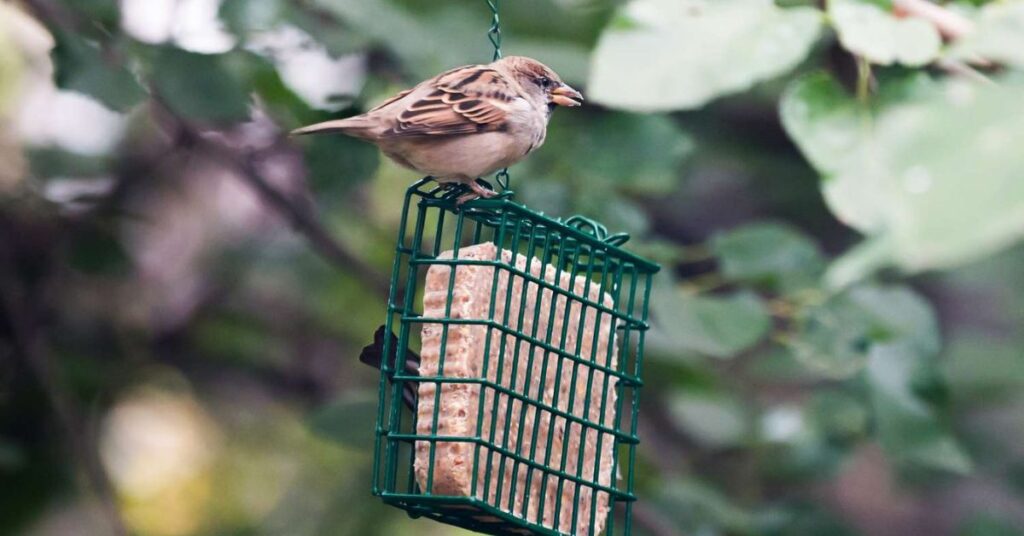
Freshening up your suet is vital not just for palatability but also for maintaining the nutritional value that birds crave. Stale suet can attract undesired pests and may even lead to health issues for feathered visitors, so regular assessments are essential.
To ensure you’re providing the freshest suet for birds, consider regularly rotating the supply in your feeders. Homemade suet cakes allow you to control ingredients and flavors while adjusting based on seasonal changes in bird behavior and preferences.
If you notice residue or unpleasant odors, it’s time to replace that batch with a fresh concoction tailored specifically for local species. Implementing these simple practices will invite vibrant flocks into your yard while fostering their well-being throughout the year.
DON’T Put Your Suet Out In Really Hot Weather
To provide suet for birds, timing is everything. During really hot weather, it’s crucial to reconsider the placement of your suet feeders. High temperatures can turn solid suet into a gooey mess that not only makes it difficult for birds to consume but can also attract unwanted pests.
The last thing you want is to create an environment that’s more inviting for insects than the delightful feathered visitors you’ve been hoping to feed.
Feeding melted suet can be detrimental to the health of your backyard friends. Birds rely on energy-dense offerings like suet during fall and spring when they require extra calories for migration and nesting preparation. In summer heat, their ability to digest these rich foods diminishes as their natural diets shift toward seeds and insects better suited for warmer months.
Consider offering alternatives, such as seed mixes or fruit slices, which are safer and more appealing options during those sweltering days while keeping your feathered companions nourished and happy!
DO Try To Squirrel-Proof Your Suet
If you’re an avid birdwatcher, you likely know how delightful it is to attract a variety of feathered friends to your backyard. To suet for birds, pesky squirrels can turn this joy into frustration. An effective squirrel-proofing strategy not only ensures that your avian visitors get their share but also helps maintain a harmonious environment where both species can thrive.
Consider investing in specially designed suet feeders that feature weight-sensitive mechanisms or cage-like barriers which allow small birds access while keeping the larger intruders at bay.
Another innovative approach involves strategically placing the suet for birds in hard-to-reach locations. Hanging feeders from thin wires or using baffles can thwart crafty squirrels looking to capitalize on easier feeding options. Incorporating natural deterrents like strong scents—think peppermint or citrus oils—around the feeding area may discourage these furry raiders without harming them.
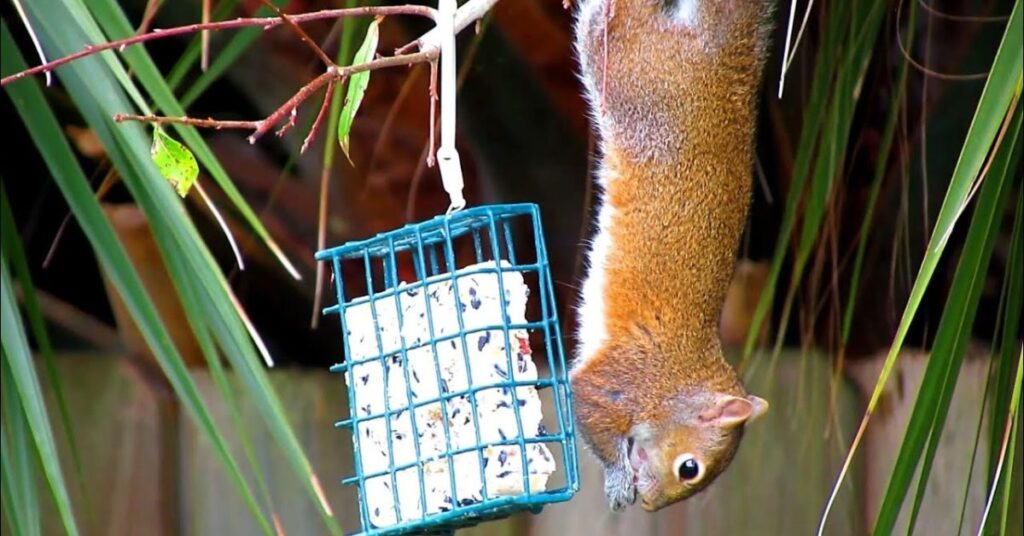
By implementing these tactics thoughtfully and creatively, you’ll create an inviting space for our feathered companions while ensuring they have uninterrupted access to their much-loved suet treats.
“If you’re trying to make your feeder squirrel-proof, check out “Select the Best Type of Squirrel-Resistant Feeder.“
Conclusion
Suet serves as a highly nutritious food source for various bird species, especially during the colder months when natural food is scarce. Its high-fat content provides essential energy that helps birds withstand harsh weather conditions and supports their overall health.
By incorporating suet into your bird feeding routine, you can attract a diverse array of feathered visitors to your backyard. Whether you choose store-bought cakes or homemade mixtures, offering suet is a simple yet effective way to support local wildlife.
FAQ’s
What Is Suet For Birds?
Suet is a high-energy food source made primarily from animal fat, commonly beef or mutton fat. It is often rendered and mixed with various ingredients like seeds, fruits, and nuts to create a nutritious treat for birds.
Suet is particularly beneficial during the colder months when birds require extra calories to maintain their body heat and energy levels. It can be found in various forms, including cakes, balls, or as loose mixtures, making it easy to offer to backyard birds.
How To Make Suet For Birds?
To start, you’ll need some basic ingredients: rendered animal fat (like beef or lamb fat), birdseed, and optional add-ins such as dried fruits, nuts, or peanut butter. Begin by melting the suet in a saucepan over low heat until it becomes liquid.
Once melted, remove it from the heat and mix in your chosen birdseed and any additional ingredients you want to include. Pour the mixture into molds—these can be muffin tins, cookie cutters, or specialized bird feeders—and let them cool until they solidify.
Afterward, you can hang the suet cakes outside using twine or place them in a feeder to attract various birds like woodpeckers, chickadees, and nuthatches.
Do Squirrels Eat Suet?
Yes, squirrels do eat suet. Suet is a high-fat food made from animal fat, often mixed with seeds, nuts, or fruits, and it is commonly used to attract birds.
Squirrels are opportunistic feeders and will readily take advantage of this energy-rich food source if it’s available. They can easily access suet placed in bird feeders, especially those designed for birds that allow only certain species to feed.
- How To Keep Bees Away From Hummingbird Feeders - March 20, 2025
- How To Attract Owls To Your Yard - March 11, 2025
- Breeding Season For Wild Birds - March 9, 2025
